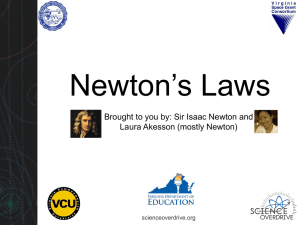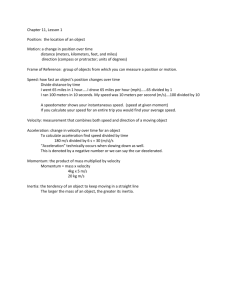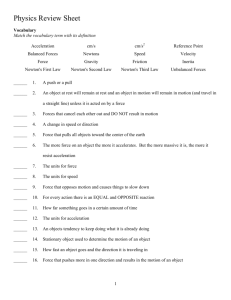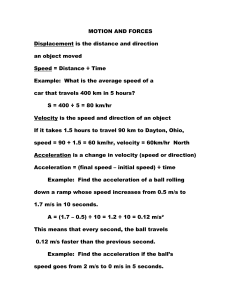Newton's Laws of Motion
advertisement
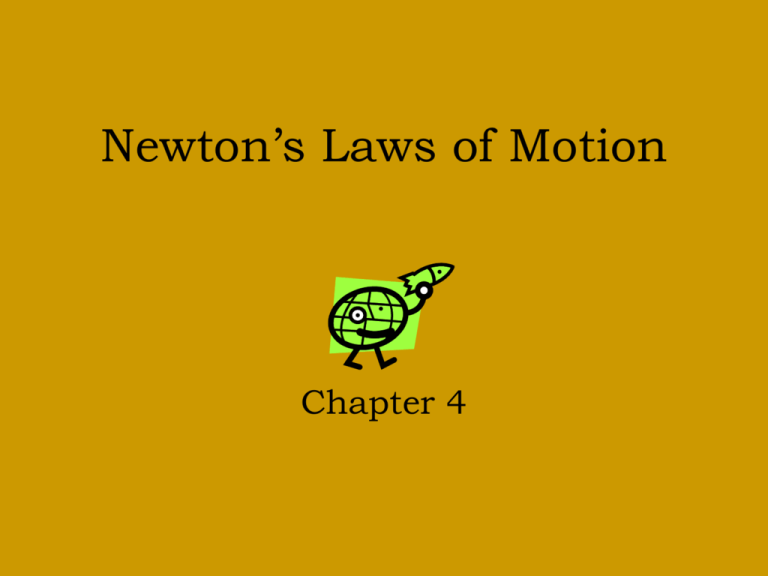
Newton’s Laws of Motion Chapter 4 Background Sir Isaac Newton (1643-1727) an English scientist and mathematician used the observations of Galilleo, Kepler and others to develop a unified, universal explanation of the motion of all bodies. We now know this as his three laws of motion. He published them in his book Philosophiae Naturalis Principia Mathematica (mathematic principles of natural philosophy) in 1687. His three laws describe the motion of all objects on the scale we experience in our everyday lives. “If I have ever made any valuable discoveries, it has been owing more to patient attention, than to any other talent.” -Sir Isaac Newton A phorce???? • A push or pull. • Contact forces • Field forces act over distances (ex. Magnetic force, gravity, electrical force) • Measured in newtons (N) • 1 Newton is about equivalent to the weight of 1/5 of a pound. How do we show forces? • With free body diagrams! • A free body diagram is a simple representation of any object as a simple rectangle or circle with forces shown as arrows, the length of which represent the magnitude of the force. • See some examples on the board… • http://www.wisconline.com/Objects/ViewObject.aspx?ID=t p1502 Inertia • The tendency of an object’s motion to remain constant, or , put another way… • The tendency of an object to resist a change in it’s motion (either speed or direction) • We may measure inertia as mass (kg) • Can you think of some low inertia objects??? • Some very high inertia objects? Newton’s First Law An object at rest tends to stay at rest and an object in motion tends to stay in motion unchanged (straight line) unless acted upon by a net external force. What does this mean? Basically, an object will “keep doing what it was doing” unless acted on by an unbalanced force. If the object was sitting still, it will remain stationary. If it was moving at a constant velocity, it will keep moving. It takes net external force to change the motion of an object. What is meant by unbalanced force (or net external force, NEF ? If the forces on an object are equal and opposite, they are said to be balanced, and the object experiences no change in motion. If they are not equal and opposite, then the forces are unbalanced and the motion of the object changes. • Another statement of Newton’s 1st law is that if there is a NEF on an object, it WILL accelerate. (It will change its speed and/or direction) • If there is no NEF, it will continue doing whatever it was doing. Some Examples from Real Life A soccer ball is sitting at rest. It takes an unbalanced net external force of a kick to change its motion. Two teams are playing tug of war. They are both exerting equal force on the rope in opposite directions. This balanced force results in no change of motion. Newton’s First Law is also called the Law of Inertia Inertia: the tendency of an object to resist changes in its state of motion The First Law states that all objects have inertia. The more mass an object has, the more inertia it has (and the harder it is to change its motion). More Examples from Real Life A powerful locomotive begins to pull a long line of boxcars that were sitting at rest. Since the boxcars are so massive, they have a great deal of inertia and it takes a large force to change their motion. Once they are moving, it takes a large force to stop them. On your way to school, a bug flies into your windshield. Since the bug is so small, it has very little inertia and exerts a very small force on your car (so small that you don’t even feel it). If objects in motion tend to stay in motion, why don’t moving objects keep moving forever? Things don’t keep moving forever because there’s almost always an unbalanced force acting upon it. A book sliding across a table slows down and stops because of the force of friction. If you throw a ball upwards it will eventually slow down and fall because of the force of gravity. In outer space, away from gravity and any sources of friction, a rocket ship launched with a certain speed and direction would keep going in that same direction and at that same speed forever. What does a = Fnet/m mean? Acceleration is directly proportional to Force Acceleration is inversely proportional to mass Newton’s Second Law Acceleration is directly proportional to Force Acceleration is inversely proportional to mass Force equals mass times acceleration. Fnet = ma What shape will it be? a (m/s2) Force (N) What shape will it be? a (m/s2) Mass (kg) Weight NOT equal to mass!!!! Fnet = ma W= • So, you have a certain weight on the earth. This weight will be different on the moon etc but mass remains the same More about F = ma If you double the mass, you double the force. If you double the acceleration, you double the force. What if you double the mass and the acceleration? (2m)(2a) = 4F Doubling the mass and the acceleration quadruples the force. So . . . what if you decrease the mass by half? How much force would be needed to have the same acceleration now? Friction • A force that opposes motion between surfaces in contact. • It is due to microscopic imperfections in the surface. Solid surfaces only make contact in a few specific points. Each point is under enormous pressure and sometimes actually bonds to the other surface (see diagram) Friction (contd.) • Friction keeps your car on the road, allows the tires to grip. • Friction wastes energy as kinetic energy is lost as heat. • Friction force depends only on three things: • Surfaces moving or not. • Force pushing surfaces together • Roughness of surfaces. What does F = ma say? F = ma basically means that Something very massive (high mass) that’s changing speed slowly (low acceleration), like a glacier, can still exert (push with) a ____________ force. Something very small (low mass) that’s changing speed very quickly (high acceleration), like a bullet, can still exert a _______ force. Something very low mass changing speed very slowly will exert a very ________ force. Newton’s Third Law If object A pushes or pulls on object B, Object B pushes or pulls on object A with the SAME force in the OPPOSITE DIRECTION. What does this mean? For every force acting on an object, there is an equal force acting in the opposite direction. Right now, gravity is pulling you down in your seat, but Newton’s Third Law says your seat is pushing up against you with equal force. This is why you are not moving. There is a balanced force acting on you– gravity pulling down, your seat pushing up. Think about it . . . What happens if you are standing on a skateboard or a slippery floor and push against a wall? You slide in the opposite direction (away from the wall), because you pushed on the wall but the wall pushed back on you with equal and opposite force. Why does it hurt so much when you stub your toe? When your toe exerts a force on a rock, the rock exerts an equal force back on your toe. The harder you hit your toe against it, the more force the rock exerts back on your toe (and the more your toe hurts). Examples • A jet engine pushes _____ backward. The ______ pushes the ______ _______ . • A rocket engine pushes ______ out and backwards, the _______ pushes the ________ __________. • A fly hits a windshield with 0.1N of force and pushes it _______ , the windshield pushes on the ________ with ___ N and pushes the fly ________. • The bat hits the baseball forward with 1200N of force, the ____hits the bat ______ with _____ N of force. Review Newton’s First Law: Objects in motion tend to stay in motion and objects at rest tend to stay at rest unless acted upon by an unbalanced force. Newton’s Second Law: Force equals mass times acceleration (F = ma). Newton’s Third Law: For every action there is an equal and opposite reaction. Vocabulary Inertia: the tendency of an object to resist changes in its state of motion Acceleration: a measurement of how quickly an object is changing speed

